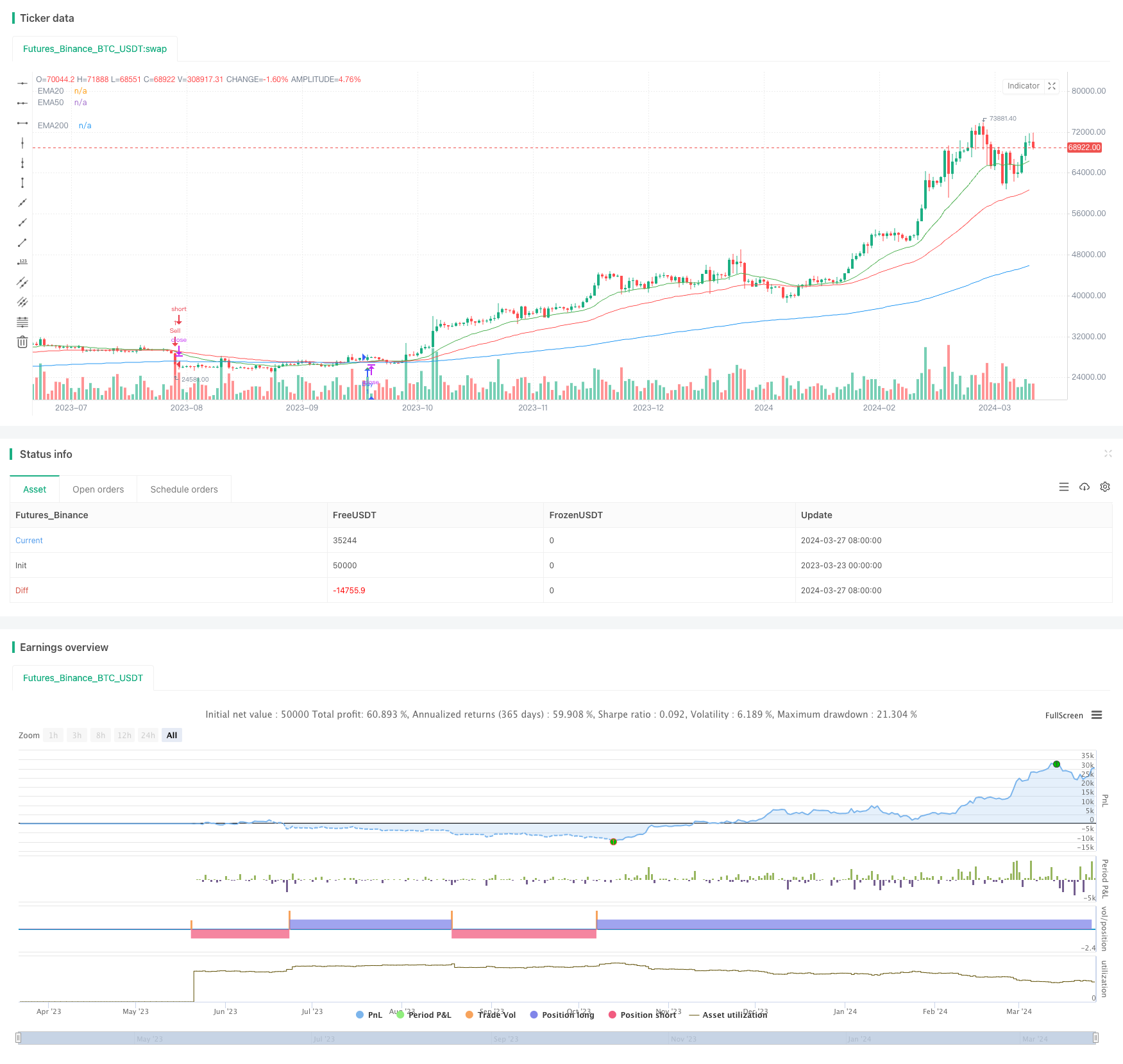
概述
该策略基于两条移动平均线(EMA)的交叉来产生交易信号。当短期EMA(20日)从下向上穿过长期EMA(50日)时,产生买入信号;当短期EMA从上向下穿过长期EMA时,产生卖出信号。同时,该策略还绘制了一条200日EMA作为长期趋势的参考。该策略的主要思路是利用不同周期移动平均线的交叉来捕捉市场趋势的转变,从而进行交易。
策略原理
- 计算20日EMA、50日EMA和200日EMA。
- 判断20日EMA和50日EMA的交叉情况:
- 当20日EMA从下向上穿过50日EMA时,产生买入信号。
- 当20日EMA从上向下穿过50日EMA时,产生卖出信号。
- 在图表上绘制20日EMA(绿色)、50日EMA(红色)和200日EMA(蓝色),以便直观观察它们的走势和交叉情况。
- 在买入和卖出信号发生时,在图表上标记出相应的买入(绿色上三角)和卖出(红色下三角)标记。
策略优势
- 简单易懂:该策略基于简单的移动平均线交叉原理,易于理解和实现。
- 趋势跟踪:通过短期和长期移动平均线的交叉,策略能够较好地捕捉市场趋势的转变,适合在趋势市场中使用。
- 长期趋势参考:策略引入了200日EMA作为长期趋势的参考,有助于判断当前市场所处的大环境。
- 直观显示:策略在图表上清晰地绘制出移动平均线和买卖信号,便于交易者直观观察和分析。
策略风险
- 震荡市场:在震荡市场中,频繁的移动平均线交叉可能产生较多的虚假信号,导致策略表现不佳。
- 滞后性:移动平均线具有一定的滞后性,可能错过市场转折的最佳时机。
- 参数敏感:策略的表现依赖于移动平均线的周期选择,不同的周期参数可能导致不同的结果。
策略优化方向
- 引入其他指标:可以考虑引入其他技术指标,如RSI、MACD等,以提高信号的可靠性和准确性。
- 优化参数:对移动平均线的周期参数进行优化,找到最适合当前市场状况的参数组合。
- 加入止损和止盈:在策略中加入合理的止损和止盈机制,以控制单笔交易的风险和盈利。
- 结合趋势判断:根据长期趋势(如200日EMA)的走向,对交易信号进行过滤,只在趋势方向上进行交易。
总结
EMA双均线交叉策略是一个简单易懂、适合趋势市场的交易策略。它利用了短期和长期移动平均线的交叉来捕捉市场趋势的转变,同时引入了长期趋势参考。尽管该策略存在一些局限性,如在震荡市场中表现不佳,以及移动平均线的滞后性,但通过引入其他指标、优化参数、加入风控措施等方式,可以进一步提升策略的稳健性和盈利能力。
策略源码
/*backtest
start: 2023-03-23 00:00:00
end: 2024-03-28 00:00:00
period: 1d
basePeriod: 1h
exchanges: [{"eid":"Futures_Binance","currency":"BTC_USDT"}]
*/
//@version=5
strategy("EMA Crossover Strategy by Peter Gangmei", overlay=true)
// Define the length for moving averages
short_ma_length = input.int(20, "Short MA Length")
long_ma_length = input.int(50, "Long MA Length")
long_ma_200_length = input.int(200, "Long MA 200 Length")
// Define start time for testing
start_time = timestamp(2024, 01, 01, 00, 00)
// Calculate current date and time
current_time = timenow
// Calculate moving averages
ema20 = ta.ema(close, short_ma_length)
ema50 = ta.ema(close, long_ma_length)
ema200 = ta.ema(close, long_ma_200_length)
// Crossing conditions
crossed_above = ta.crossover(ema20, ema50)
crossed_below = ta.crossunder(ema20, ema50)
// Entry and exit conditions within the specified time frame
if true
if (crossed_above)
strategy.entry("Buy", strategy.long)
alert("Buy Condition", alert.freq_once_per_bar_close)
if (crossed_below)
strategy.entry("Sell", strategy.short)
alert("Sell Condition", alert.freq_once_per_bar_close)
// Plotting moving averages for visualization
plot(ema20, color=color.green, title="EMA20")
plot(ema50, color=color.red, title="EMA50")
plot(ema200, color=color.blue, title="EMA200")
// Placing buy and sell markers
plotshape(series=crossed_above, style=shape.triangleup, location=location.belowbar, color=color.green, size=size.small, title="Buy Signal")
plotshape(series=crossed_below, style=shape.triangledown, location=location.abovebar, color=color.red, size=size.small, title="Sell Signal")